- Home
- About Journals
-
Information for Authors/ReviewersEditorial Policies
Publication Fee
Publication Cycle - Process Flowchart
Online Manuscript Submission and Tracking System
Publishing Ethics and Rectitude
Authorship
Author Benefits
Reviewer Guidelines
Guest Editor Guidelines
Peer Review Workflow
Quick Track Option
Copyediting Services
Bentham Open Membership
Bentham Open Advisory Board
Archiving Policies
Fabricating and Stating False Information
Post Publication Discussions and Corrections
Editorial Management
Advertise With Us
Funding Agencies
Rate List
Kudos
General FAQs
Special Fee Waivers and Discounts
- Contact
- Help
- About Us
- Search

The Open Fuels & Energy Science Journal
(Discontinued)
ISSN: 1876-973X ― Volume 11, 2018
Design and Construction of A Domestic Solar Power Bank in a Convective Environment
M. E. Emetere1, 2, *, O.I. Osunlola1, A.D. Adejumo1, A.O. Dauda1
Abstract
Objective:
This research seeks to solve the problem of storing solar energy in small scale modules for domestic use.
Method:
The Solar Power Bank (SPB) was constructed with local materials based on their individual properties. The functionality of the SPB was tested in a convective environment. Davis automatic Weather Station (DWS) was used to get the weather parameters (like solar irradiance, solar energy and temperature) for each day the SPB was tested. The maximum solar irradiance for four days (during the experiment) were 220 W/m2, 208 W/m2, 450 W/m2 and 900 W/m2. The maximum solar energy was 0.33 J, 03 J, 0.64 J and 1.33 J.
Result:
The maximum voltage and power obtained from the Solar Power Bank (SPB) was 0.18V and 0.065W respectively. The design showed tremendous heat energy entrapment during solar irradiance peak as the temperature in the SPB was about three times the DWS.
Conclusion:
It was specifically noted that the convection of the heat transfer that is triggered by the glass shield determines the functionality of the thermo-electric module. This is a clear indication that though the power output may be low to charge the batteries, the prospects of the SPB to operate in convective-rural communities (in tropic region) is very high.
Article Information
Identifiers and Pagination:
Year: 2018Volume: 11
First Page: 16
Last Page: 28
Publisher Id: TOEFJ-11-16
DOI: 10.2174/1876973X01811010016
Article History:
Received Date: 19/11/2017Revision Received Date: 08/01/2018
Acceptance Date: 9/01/2018
Electronic publication date: 13/03/2018
Collection year: 2018
open-access license: This is an open access article distributed under the terms of the Creative Commons Attribution 4.0 International Public License (CC-BY 4.0), a copy of which is available at: https://creativecommons.org/licenses/by/4.0/legalcode. This license permits unrestricted use, distribution, and reproduction in any medium, provided the original author and source are credited.
* Address correspondence to this author at the Physics Department, Covenant University Canaan land, P.M.B 1023, Ota, Nigeria; Tel: +2348035267598; E-mail: emetere@yahoo.com
| Open Peer Review Details | |||
|---|---|---|---|
| Manuscript submitted on 19-11-2017 |
Original Manuscript | Design and Construction of A Domestic Solar Power Bank in a Convective Environment | |
1. INTRODUCTION
Solar energy is a very vital source of renewable energy because it is readily available all year round [1Daudu, H.A. Design and development of a solar conical concentrator. Int. J. Energy Res., 2002, 6(1), 73-81.]. In 2000, the United Nations Development Programme discovered that the yearly potential of solar energy was 1575-49837 exajoules (EJ), which is greater than the total world energy consumption that was 559.8 EJ in the year 2012 [2KWES-Key World Energy Statistics. iea.org. IEA., 2014, 6, 24-28.]. This means that if solar energy is adequately utilized, there will be enough energy for every consumer in the nearest future. Solar energy can be stored in solar energy storage system and be used at any time in the day. However, there are some regions of the globe which have limited supply of solar irradiance. In this case, new solar technologies are emerging to ensure adequate usage of limited solar irradiance.
Solar energy storage systems have been improved via recent technologies that allow excess solar energy to be collected and saved for longer period. Recently, there are a great number of growing facilities or equipment which use Seasonal Thermal Energy Storage (STES). STES enables solar energy to be stored in summer for space heating during winter in parts of the polar regions of the world [3Wong, B. 2011.Drake Landing Solar Community. IDEA/CDEA District Energy/CHP 2011 Conference in Toronto, June 26-29, 2011]. In rural communities of developing countries, there are fewer energy options (e.g. hydro-power, nuclear power, thermal power, etc.) to meet its domestic energy requirement. Moreover, energy generation in developing countries is plagued with various fundamental challenges [4Emetere, M.E.; Okoro, U.; Etete, B.; Okunbor, G. Free energy option and its relevance to improve domestic energy demands in southern Nigeria. Energy Reports, 2016, 2, 229-236.
[http://dx.doi.org/10.1016/j.egyr.2016.09.001] ]. For example, Nigeria Electricity consumption per capital within 2010 and 2014 is 149KWh [5World Bank. Electric power consumption (kWh per capita), http://www.data.worldbank.org/ indicator/EG.USE.ELEC.KH.PC., 2015. (Accessed: 7th December, 2016)]. Hence, energy crisis in Nigeria has lingered for four decades [6 ONEC Department Report, (2013). Nigerian power sector privatization program appraisal report. Partial risk guarantee in support of the power sector privatization program.
]. This study seeks the cheapest way to resolve the lingering challenges of solar energy storage for rural dwellers in parts of Nigeria.
The recent use of thermoelectric generators (STEGs) and solar collectors have yielded tremendous results in modern engineering designs. STEGs are solid-state devices used to convert thermal energy generated into electrical energy. At the moment, there is on-going research on improving the robustness of STEG to operate in uncommon environmental conditions. It is envisaged that current improvements on STEGs would enhance direct solar-to-electric energy conversion in the nearest future. STEG operate by absorbing sunlight. The absorbed solar energy creates temperature gradient, which in turn, produces electricity through the Seebeck effect. The efficiency of STEG depends on the solar irradiance, temperature difference across the device and thermal properties of the device. The thermoelectric efficiency can be written mathematically as:
 |
(1) |
where S is the Seebeck coefficient, σ is the electrical conductivity, k is the thermal conductivity, and T is the absolute temperature [7Olsen, M.; Warren, E.; Parilla, P.; Toberer, E.; Kennedy, C.; Synder, G.A. High temperature, High-efficiency solar thermoelectric generator prototype. Energy Procedia, 2014, 49, 1460-1469.
[http://dx.doi.org/10.1016/j.egypro.2014.03.155] ]. The maximum efficiency [8Rowe, D. Thermoelectric waste heat recovery as a renewable energy source. Int. J. Innovations in Energy Syst. Power, 2006, 1(1), 13-26.] of a TEG is given by:
 |
(2) |
η is the Carnot efficiency, TH is the temperature of the hot side of the device, TC is the cold-side temperature and Z is the temperature gradient. The total efficiency of the STEG is the product of ηTE and the absorber efficiency ηabs [12Baranowski, L.L.; Synder, G.J.; Toberer, E.S. Concentrated solar thermoelectric generators. Energy Environ. Sci., 2012, 5, 9055-9067.
[http://dx.doi.org/10.1039/c2ee22248e] ].
In this study, the thermal energy produced by the solar collector is transferred to the STEG. The STEG converts the heat energy to electrical energy and it is stored in a battery for use-hours later. A solar collector is a unique form of a heat exchanger that converts solar radiation energy into thermal energy [9Kalogirou, S. Solar thermal collectors and applications. Pror. Energy Combust. Sci., 2004, 30(3), 231-295.
[http://dx.doi.org/10.1016/j.pecs.2004.02.001] , 10Tian, Y.; Zhao, C.Y. A review of solar collectors and thermal energy storage in solar thermal applications. Appl. Energy, 2013, 104, 538-553.
[http://dx.doi.org/10.1016/j.apenergy.2012.11.051] ]. Few experiments have shown that the thermal energy generated is stored in a tank-filled with circulating fluids.
Goldsmid and Cochrane [11Goldsmid, H.J.; Cochrane, J.W. Solar thermoelectric generators Proceedings of the 4th IEEE International Conference on Thermoelectric Energy Conversion, Arlington, TX, USA1982.] designed a thermoelectric generator using a solar collector with a non-tracking concentrator. Their design was majorly made of alloys with a maximum operating temperature of 200°C. In their research they proposed that “ZT” (equation 1) can be increased by raising the carrier concentration. This concept was adopted by our research team i.e. using local materials.
In recent time, scientists have tried to improve the efficiency of the Solar Thermo-Electric Generator (STEG) to at least above 15%. Olsen et al. [7Olsen, M.; Warren, E.; Parilla, P.; Toberer, E.; Kennedy, C.; Synder, G.A. High temperature, High-efficiency solar thermoelectric generator prototype. Energy Procedia, 2014, 49, 1460-1469.
[http://dx.doi.org/10.1016/j.egypro.2014.03.155] ] worked on the prototype design of STEG. They suggested the inclusion of solar-selective absorber materials and a thermally insulating cavity to ensure high absorptivity of solar radiation of the thermo-electric module. This idea is quite novel only if the cost of production is low. This idea was adopted in designing the interior of our device. However, the general challenge of this method is the production of very low voltage compared to the natural capacity of the thermo-electric module. There are better STEG designs with higher efficiency [12Baranowski, L.L.; Synder, G.J.; Toberer, E.S. Concentrated solar thermoelectric generators. Energy Environ. Sci., 2012, 5, 9055-9067.
[http://dx.doi.org/10.1039/c2ee22248e] -14Orr, B.; Taglieri, J.; Ding, L.C.; Akbarzadeh, A. Validating an alternative method to predict thermoelectric generator performance. Energy Convers. Manage., 2016, 116, 134-141.
[http://dx.doi.org/10.1016/j.enconman.2016.02.074] ] but the major disadvantage is the cost of production. This study is targeted on the average rural settlement in developing countries. The main objective of this study is to reduce the cost of production of SPB i.e. using local materials. The objectives of this study are: i) to study the heat energy that can be trapped by a 3 mm and 4 mm glass shield; to advance the functionality of a TEG system in a convective environment; ii) and to construct a solar thermoelectric generator using thermoelectric converter, aluminum casing and digital temperature sensor.
2. METHODOLOGY
In this study, the concept of a solar power generation system consists of batteries, low emissivity glass and the aluminum sheet plates. When light from the sun is collected by the flat solar collector, it is directed on the focus point where the thermoelectric generators are mounted. The working principle simply is that as one side of the thermoelectric generator is heated; the other side’s temperature is lower (cool side) then a temperature difference is generated within thermoelectric module. This event leads to the generation of electricity.
In the SPB design, a mini-model or pattern was created with a cardboard material. Then its dimension of mm was measured to understand the physics of the solar compartment. After initial evaluation, the cardboard pattern for the rechargeable battery compartment was then measured to be 590 × 480mm. The cardboard pattern was used to construct the Solar Power Bank (SPB)-case using 4 x 3 mm thick aluminum plate. The bending of the thick aluminum plate for the solar collector and battery compartments was carried out via a bench vice and later the plate was hammered into shape. The aluminum plate was acquired and marked out to the necessary size according to the specifications. The desired shape was cut out before it was folded to the required shape with length of 1120 mm and breadth of 910 mm. The aluminum plate is a very vital component in this model due to the qualities such as; high tensile strength and good thermal and electrical conductivity.
The cutting process was performed with the use of hacksaw tool. Subsequently, holes were drilled on the aluminum plate through the use of a pillar drilling machine and 4 mm drill bit. The holes are necessary for 5 mm bolts and nuts to be used for the fitting of the structure. The finishing touches to the device were the joining of the solar collector and battery compartment. The fixing of plastic air trapper and a digital temperature sensor was the last step of the construction Figs. (1 and 2
and 2 ). A 3 mm and 4 mm glass was used for the surface of the SPB device shown in Fig. (2
). A 3 mm and 4 mm glass was used for the surface of the SPB device shown in Fig. (2 ). Six thermoelectric converters were used. The cool side of the thermoelectric module was placed on a white insulator with considerable thickness to keep the cold side of the thermoelectric module minimally cool to ensure that there is a differential in the operational temperature of both sides of the thermoelectric module Fig. (1
). Six thermoelectric converters were used. The cool side of the thermoelectric module was placed on a white insulator with considerable thickness to keep the cold side of the thermoelectric module minimally cool to ensure that there is a differential in the operational temperature of both sides of the thermoelectric module Fig. (1 ). This idea partially explains the mathematical representation in equations 1 and 2. This cooling approach may not be the best but we are more interested in the construction of a low-cost solar power saving device. Obviously the work is still ongoing. After the construction of the solar thermoelectric generator, some readings were taken for some days using a multimeter and digital thermometer. The parameters include the temperature in the solar chamber and total voltage generated by the TEG modules. The readings were taken for a time frame of 15 minutes for 2 hours (i.e. 1PM-3PM) daily. The computation of the datasets was carried out using MATLAB 2013 and Microsoft Excel.
). This idea partially explains the mathematical representation in equations 1 and 2. This cooling approach may not be the best but we are more interested in the construction of a low-cost solar power saving device. Obviously the work is still ongoing. After the construction of the solar thermoelectric generator, some readings were taken for some days using a multimeter and digital thermometer. The parameters include the temperature in the solar chamber and total voltage generated by the TEG modules. The readings were taken for a time frame of 15 minutes for 2 hours (i.e. 1PM-3PM) daily. The computation of the datasets was carried out using MATLAB 2013 and Microsoft Excel.
 |
Fig. (1) Initial Construction of SPB. |
Some mathematical formulas were used to calculate parameters such as; the power generated from the STEG, heat transfer within the STEG and the maximum heat power expected in the SPB. The mathematical representation includes power, heat transfer and expected maximum power generated from the heating device:
 |
(3) |
 |
(4) |
 |
(5) |
Here, V is the voltage generated by the TEG, R is the resistance within TEG module, t is the time, K is the thermal conductivity, A is the cross sectional area of TEG module, T is the change in temperature within TEG module and d is the thickness of TEG module.
When heat in form of solar energy is applied to the hot side of the TEG modules a reaction occurs in the inbuilt components of the TEG modules thereby causing electricity to be produced, two panes of glass with thickness 3 mm and 4 mm will cover the top of the solar compartment. The glass retains the heat from the sun which enables the TEG modules to generate electricity. An insulation tape is used to secure trapped heat. The specifications for the TEG modules are listed below:
- MODEL: TEC 1-12706
- SIZE: 40mm × 40mm × 4mm
- OPERATIONAL TEMPERATURES:
- MAX POWER CONSUMPTION: 60 Watts
- OPERATIONAL AMPERES: 0-15.2 V DC and 0-6 A
- NET WEIGHT: 22 g
- COLOR: White
The weather parameters (i.e. solar radiation, temperature and solar energy) of the study location were obtained using the Davis Weather Station (DWS) installed in the host institution. The length of the SPB was chosen based on the number of TEG. The depth and width of the SPB was calculated to avoid excessively trapped heat energy.
 |
Fig. (2) Completed SPB construction. |
3. RESULTS AND DISCUSSION
The 3 mm and 4 mm were interchanged on the SPB to determine the temperature, voltage, power output and heat transferred. The measured and derived readings for Day 1 are shown in Figs. (3a -d
-d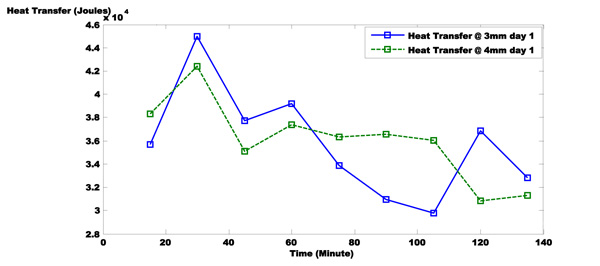 ). The 3 mm and 4 mm glass shields on day 1 show that the temperature in the trapped thermal environment was at the highest for 30 mins. The downward thermal trend for both glass shields is because of the reduced solar irradiance. However, while the 4 mm glass shield could retain heat trapped, the 3 mm shield loses heat. However, towards the end of the day/experiment, the 4 mm glass shield loses more heat. Aside the glass properties of the shield, it is noted that the aluminum casing temperature could ramp temperature from 32 ambient temperature to 57 . The voltage output shows that the heat trapped in the 3 mm glass shield is more favourable to the TEG Fig. (3b
). The 3 mm and 4 mm glass shields on day 1 show that the temperature in the trapped thermal environment was at the highest for 30 mins. The downward thermal trend for both glass shields is because of the reduced solar irradiance. However, while the 4 mm glass shield could retain heat trapped, the 3 mm shield loses heat. However, towards the end of the day/experiment, the 4 mm glass shield loses more heat. Aside the glass properties of the shield, it is noted that the aluminum casing temperature could ramp temperature from 32 ambient temperature to 57 . The voltage output shows that the heat trapped in the 3 mm glass shield is more favourable to the TEG Fig. (3b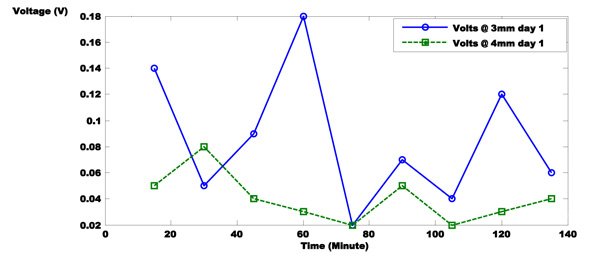 ). Also, it should be noted that highest temperature does not favour a corresponding voltage output (as shown in Fig. 3b
). Also, it should be noted that highest temperature does not favour a corresponding voltage output (as shown in Fig. 3b ) or power output Fig. (3c
) or power output Fig. (3c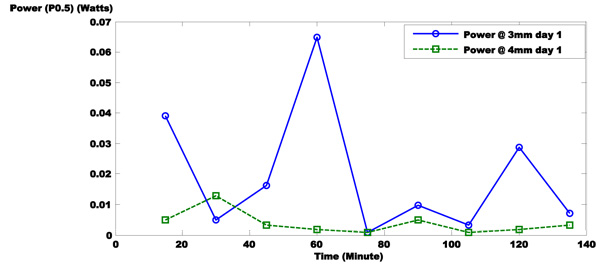 ). This means that the convection of the heat transfer that is triggered by the glass shield determines the functionality of the TEG. Fig. (3d
). This means that the convection of the heat transfer that is triggered by the glass shield determines the functionality of the TEG. Fig. (3d ) shows that the heat trapped in the device can be as high as 45 kJ. It was observed that the trend for temperature, voltage, power and heat transfer occurred in Fig. (4
) shows that the heat trapped in the device can be as high as 45 kJ. It was observed that the trend for temperature, voltage, power and heat transfer occurred in Fig. (4 -6a
-6a ).
).
 |
Fig. (3a) Graph of Temperature against Time for 3mm and 4mm glass- day 1. |
 |
Fig. (3b) Graph of Voltage against Time for 3mm and 4mm glass- day 1. |
 |
Fig. (3c) Graph of Power against Time for 3mm and 4mm glass-day 1. |
 |
Fig. (3d) Graph of Heat Transfer against Time for 3mm and 4mm glass-day 1. |
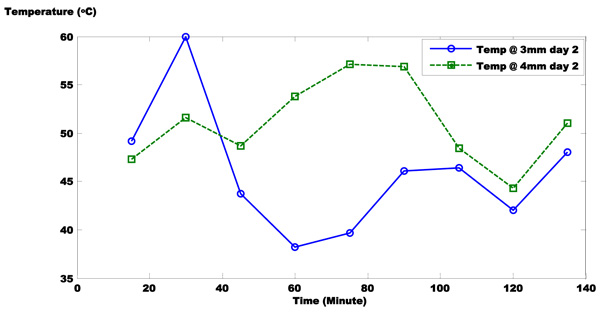 |
Fig. (4a) Graph of Temperature against Time for 3mm and 4mm glass-day 2. |
The trending in Figs. (3a -5a
-5a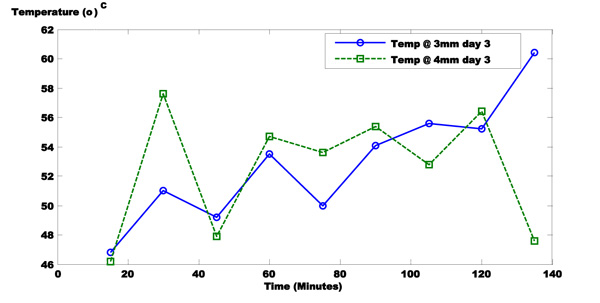 ) is somewhat interesting. The heat trapped in 3 mm glass shield can drop as low as before it picks up at 120 minutes Fig. (4a
) is somewhat interesting. The heat trapped in 3 mm glass shield can drop as low as before it picks up at 120 minutes Fig. (4a ). Unlike the usual trend, the 4 mm glass shield had its highest temperature at 70 minutes but it was not as high as the 3 mm glass shield. At this point, the voltage output increased to 0.12 V which was the highest voltage for both glass shields Fig. (4b
). Unlike the usual trend, the 4 mm glass shield had its highest temperature at 70 minutes but it was not as high as the 3 mm glass shield. At this point, the voltage output increased to 0.12 V which was the highest voltage for both glass shields Fig. (4b ). While the highest power output was 0.029 W Fig. (4c
). While the highest power output was 0.029 W Fig. (4c ) the heat energy trapped within the chamber was 47 kJ Fig. (4d
) the heat energy trapped within the chamber was 47 kJ Fig. (4d ). This is a clear indication that though the power output may be low to charge the batteries, the prospects of the SPB to operate in the rural communities of the tropics is very high.
). This is a clear indication that though the power output may be low to charge the batteries, the prospects of the SPB to operate in the rural communities of the tropics is very high.
 |
Fig. (4b) Graph of Voltage against Time for 3mm and 4mm glass-day 2. |
 |
Fig. (4c) Graph of Power against Time for 3mm and 4mm glass-day 2. |
 |
Fig. (4d) Graph of Heat Transfer against Time for 3mm and 4mm glass-day 2. |
 |
Fig. (5a) Graph of Temperature against Time for 3mm and 4mm glass-day 3. |
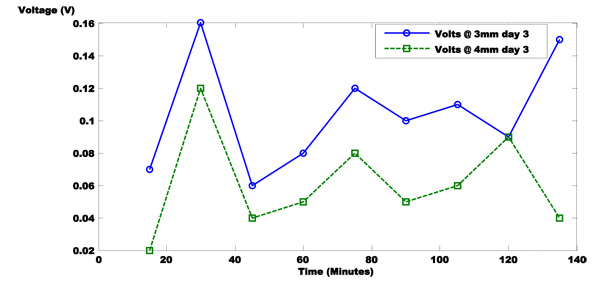 |
Fig. (5b) Graph of Voltage against Time for 3mm and 4mm glass-day 3. |
 |
Fig. (5c) Graph of Power against Time for 3mm and 4mm glass-day 3. |
 |
Fig. (5d) Graph of Heat Transfer against Time for 3mm and 4mm glass-day. |
The 4 mm glass shield had two significant peaks i.e. 70th and 120th minute. Likewise, the temperature values for the 3 mm glass shield was not stable at all but the temperature peaked at the 20th minute (Fig. 5a ). The 4 mm glass shield recorded the highest voltage i.e. 0.23 V at the 120th minute (Fig. 5b
). The 4 mm glass shield recorded the highest voltage i.e. 0.23 V at the 120th minute (Fig. 5b ). The power was also as high as 0.1 W (Fig. 5
). The power was also as high as 0.1 W (Fig. 5 ). This further affirms that the heat transfer pattern is a major factor that must be considered in designing SPB. The heat trapped was as high as 49 kJ (Fig. 5d
). This further affirms that the heat transfer pattern is a major factor that must be considered in designing SPB. The heat trapped was as high as 49 kJ (Fig. 5d ). It was also observed that Figs. (6a
). It was also observed that Figs. (6a -d
-d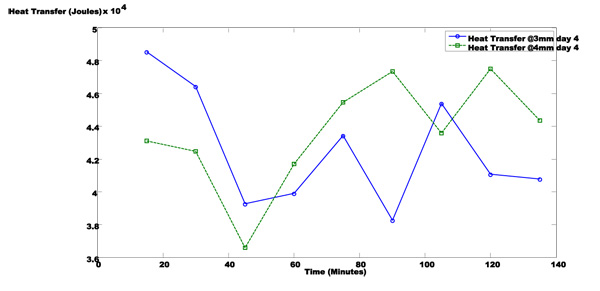 ) observed almost same trend as Fig. (5a
) observed almost same trend as Fig. (5a ). Based on the above, the efficiency of the SPB was calculated to be approximately 15.1%. The wavy pattern of the parameters in Figs. (3a
). Based on the above, the efficiency of the SPB was calculated to be approximately 15.1%. The wavy pattern of the parameters in Figs. (3a -6a
-6a ) are due to the convective system of the study area which have been explained in Emetere et al. [15Emetere, M.E.; Akinyemi, M.L.; Edeghe, E.B. A simple technique for sustaining solar energy production in active convective coastal regions. Int. J. Photoenergy, 2016, 3567502, 1-11.
) are due to the convective system of the study area which have been explained in Emetere et al. [15Emetere, M.E.; Akinyemi, M.L.; Edeghe, E.B. A simple technique for sustaining solar energy production in active convective coastal regions. Int. J. Photoenergy, 2016, 3567502, 1-11.
[http://dx.doi.org/10.1155/2016/3567502] -18Emetere, M.E. Impacts of recirculation event on aerosol dispersion and rainfall patterns in parts of Nigeria. Glob. NEST J., 2017, 19(2), 344-352.].
The convective nature is illustrated by the temperature Figs. (7a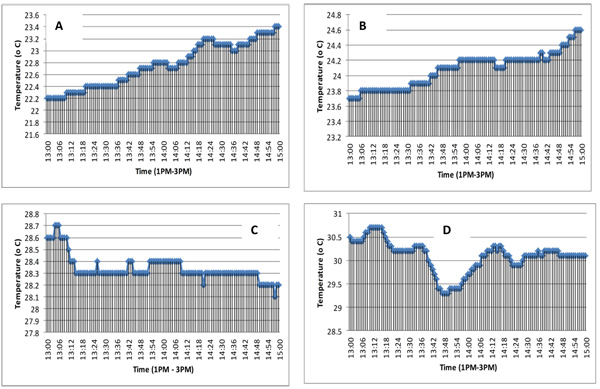 -d
-d ), solar irradiation Figs. (8a
), solar irradiation Figs. (8a -d
-d ) and solar energy Figs. (9a
) and solar energy Figs. (9a -d
-d ) that was obtained from the Davis Weather Station (DWS). The first, second, third and fourth day measurements are depicted by letters ‘a’, ‘b’, ‘c’ and ‘d’ respectively. The maximum solar irradiance for four days were 220 W/m2, 208 W/m2, 450 W/m2 and 900 W/m2 consecutively (Figs. 8a
) that was obtained from the Davis Weather Station (DWS). The first, second, third and fourth day measurements are depicted by letters ‘a’, ‘b’, ‘c’ and ‘d’ respectively. The maximum solar irradiance for four days were 220 W/m2, 208 W/m2, 450 W/m2 and 900 W/m2 consecutively (Figs. 8a -d
-d ). The maximum solar energy was 0.33 J, 03 J, 0.64 J and 1.33 J (Figs. 9a
). The maximum solar energy was 0.33 J, 03 J, 0.64 J and 1.33 J (Figs. 9a -d
-d ).
).
 |
Fig. (6a) Graph of Temperature against Time for 3mm and 4mm glass-day 4. |
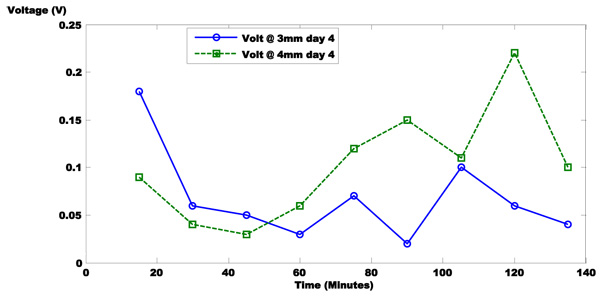 |
Fig. (6b) Graph of Voltage against Time for 3mm and 4mm glass-day 4. |
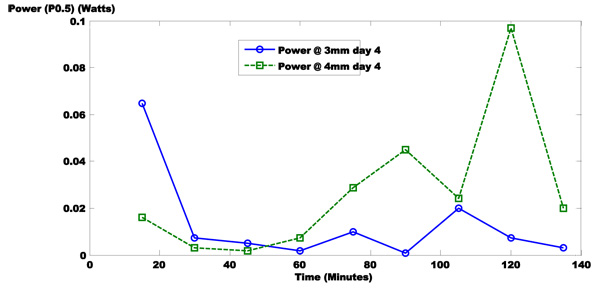 |
Fig. (6c) Graph of Power against Time for 3mm and 4mm glass-day 4. |
 |
Fig. (6d) Graph of Heat Transfer against Time for 3mm and 4mm glass-day 4. |
 |
Fig. (7) Temperature obtained from DWS (a) first day (b) second day (c) third day(d)fourth day. |
 |
Fig. (8) Solar irradiation obtained from DWS (a) first day (b) second day (c) third day(d)fourth day. |
 |
Fig. (9) Solar energy obtained from DWS (a) first day (b) second day (c) third day(d)fourth day. |
The maximum temperature for four days were 23.2oC, 24.6oC, 28.7oC and 30.8oC consecutively Figs. (8a -d
-d ). It was observed that the temperature in the SPB is thrice the DWS at some point. At the maximum DWS temperature, the SPB temperature is almost twice the DWS temperature.
). It was observed that the temperature in the SPB is thrice the DWS at some point. At the maximum DWS temperature, the SPB temperature is almost twice the DWS temperature.
CONCLUSION
The prospects of embarking on the solar power bank is very viable in the rural communities of the tropics. The maximum solar irradiance values for four days were 220 W/m2, 208 W/m2, 450 W/m2 and 900 W/m2 consecutively. The maximum solar energy was 0.33 J, 03 J, 0.64 J and 1.33 J. The maximum voltage and power obtained from the Solar Power Bank (SPB) are given as 0.18 V and 0.065 W, respectively. The design showed tremendous heat energy entrapment during solar irradiance peak as the temperature in the SPB was about three times the temperature measured by the DWS. It was specifically noted that the convection of the heat transfer that is triggered by the glass shield determines the functionality of the TEG. This is a clear indication that though the power output may be low to charge the batteries, the prospects of the SPB to operate in the rural communities of the tropics are very high. However, there were challenges to guide future construction. This includes scarce thermoelectric modules in the markets of developing countries; modes of optimizing the Seebeck efficiency; and the false ratings of the TEG specification.
This research project is highly recommended for the rural areas and slums located in the urban areas that cannot afford PV modules due to their high cost. From the above findings, a robust cooling system of the solar power bank is recommended.
CONSENT FOR PUBLICATION
Not applicable.
CONFLICT OF INTEREST
The authors declare no conflict of interest, financial or otherwise.
ACKNOWLEDGEMENTS
The authors acknowledge the partial sponsorship of the host university. The authors also appreciate Department of Physics, Covenant University for the DWS dataset.
REFERENCES
| [1] | Daudu, H.A. Design and development of a solar conical concentrator. Int. J. Energy Res., 2002, 6(1), 73-81. |
| [2] | KWES-Key World Energy Statistics. iea.org. IEA., 2014, 6, 24-28. |
| [3] | Wong, B. 2011.Drake Landing Solar Community. IDEA/CDEA District Energy/CHP 2011 Conference in Toronto, June 26-29, 2011 |
| [4] | Emetere, M.E.; Okoro, U.; Etete, B.; Okunbor, G. Free energy option and its relevance to improve domestic energy demands in southern Nigeria. Energy Reports, 2016, 2, 229-236. [http://dx.doi.org/10.1016/j.egyr.2016.09.001] |
| [5] | World Bank. Electric power consumption (kWh per capita), http://www.data.worldbank.org/ indicator/EG.USE.ELEC.KH.PC., 2015. (Accessed: 7th December, 2016) |
| [6] | ONEC Department Report, (2013). Nigerian power sector privatization program appraisal report. Partial risk guarantee in support of the power sector privatization program. |
| [7] | Olsen, M.; Warren, E.; Parilla, P.; Toberer, E.; Kennedy, C.; Synder, G.A. High temperature, High-efficiency solar thermoelectric generator prototype. Energy Procedia, 2014, 49, 1460-1469. [http://dx.doi.org/10.1016/j.egypro.2014.03.155] |
| [8] | Rowe, D. Thermoelectric waste heat recovery as a renewable energy source. Int. J. Innovations in Energy Syst. Power, 2006, 1(1), 13-26. |
| [9] | Kalogirou, S. Solar thermal collectors and applications. Pror. Energy Combust. Sci., 2004, 30(3), 231-295. [http://dx.doi.org/10.1016/j.pecs.2004.02.001] |
| [10] | Tian, Y.; Zhao, C.Y. A review of solar collectors and thermal energy storage in solar thermal applications. Appl. Energy, 2013, 104, 538-553. [http://dx.doi.org/10.1016/j.apenergy.2012.11.051] |
| [11] | Goldsmid, H.J.; Cochrane, J.W. Solar thermoelectric generators Proceedings of the 4th IEEE International Conference on Thermoelectric Energy Conversion, Arlington, TX, USA1982. |
| [12] | Baranowski, L.L.; Synder, G.J.; Toberer, E.S. Concentrated solar thermoelectric generators. Energy Environ. Sci., 2012, 5, 9055-9067. [http://dx.doi.org/10.1039/c2ee22248e] |
| [13] | Jung, Y.S.; Jeong, D.H.; Kang, S.B.; Kim, F.; Jeong, M.H.; Lee, K.S.; Son, J.S.; Baik, J.M.; Kim, J.S.; Choi, K.J. Wearable solar thermoelectric generator driven by unprecedentedly high temperature difference. Nano Energy, 2017, 40, 663-672. [http://dx.doi.org/10.1016/j.nanoen.2017.08.061] |
| [14] | Orr, B.; Taglieri, J.; Ding, L.C.; Akbarzadeh, A. Validating an alternative method to predict thermoelectric generator performance. Energy Convers. Manage., 2016, 116, 134-141. [http://dx.doi.org/10.1016/j.enconman.2016.02.074] |
| [15] | Emetere, M.E.; Akinyemi, M.L.; Edeghe, E.B. A simple technique for sustaining solar energy production in active convective coastal regions. Int. J. Photoenergy, 2016, 3567502, 1-11. [http://dx.doi.org/10.1155/2016/3567502] |
| [16] | Subiantoro, A.; Ooi, K.T. Analytical models for the computation and optimization of single and double glazing flat plate solar collectors with normal and small air gap spacing. Appl. Energy, 2013, 104, 392-399. [http://dx.doi.org/10.1016/j.apenergy.2012.11.009] |
| [17] | Emetere, M.E.; Akinyemi, M.L. Prospects of solar energy in the coastal areas of Nigeria. InAIP Conference Proceedings 2016 Feb 1 (Vol. 1705, No. 1, p. 020035), AIP Publishing |
| [18] | Emetere, M.E. Impacts of recirculation event on aerosol dispersion and rainfall patterns in parts of Nigeria. Glob. NEST J., 2017, 19(2), 344-352. |



